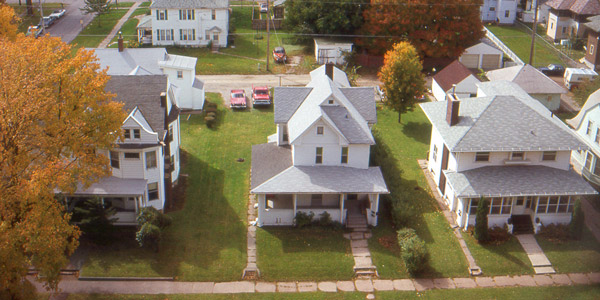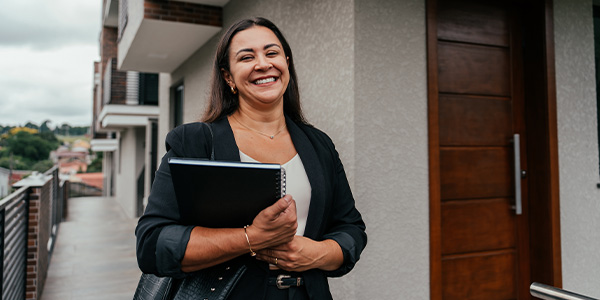Homebuyers
USDA Loans: Closer to Cities Than You Might Expect
June 20, 2024
Last year, Taylor Black, 23, and Jackson Dostal, 21, bought a charming three-bedroom house in Maquoketa, Iowa. They did so with no money down and a mortgage payment that is much lower than what most of their friends pay for rent in the city of Davenport, about a 45-minute drive south.
The couple became first-time homeowners through a USDA loan. The mortgage, backed by the U.S. Department of Agriculture, promotes homeownership in eligible rural and suburban areas. But here's the twist—these loans aren't as rural as you might think.

Taylor Black and Jackson Dostal in front of their new home in Maquoketa, Iowa. Photo provided by Black.
Black, 24, a special education teacher, and Dostal, 22, who works for a logging company, don't mind living outside of a major city. That’s because doing so helped them to become homeowners.
Over the last decade, there has been a shift as many millennials have chosen suburban and further out suburban areas over the pricier cities, according to a 2024 report from the Joint Center for Housing Studies of Harvard University. This is at least partly a result of rising home prices and high mortgage rates, hovering around 7%. (The rates are according to the most recent Freddie Mac data.)
It's not just younger generations considering moving to rural areas. If telecommuting is an option, 66% of Americans surveyed in 2021 by Paulsen and Audience Audit indicated they would consider moving to a rural home or subdivision.
"I think it's remarkable that at our age, we're fortunate enough to buy our first home together," said Black. “I don't feel isolated at all … I like small towns."

Types of USDA loans
The USDA offers several different types of loan programs for interested homebuyers.
Buyers can explore USDA direct loans. These loans are issued directly by the USDA instead of through a lender. They are designed for lower-income households and can offer interest rates as low as 1% APR.
There are also USDA loan guarantees. These are similar to VA and FHA loans. A lender partners with the USDA and issues the mortgage and the USDA backs it. The USDA guarantee lets lenders offer lower interest rates. The lender will underwrite the loan, but the USDA will give final approval. Also, check out the difference between USDA vs FHA loans.
In addition, the USDA offers home improvement loans for very-low-income homeowners, defined as those earning below 50% of the area median income. These loans can be used to repair or modernize existing homes, which may be beneficial for seniors to improve home safety by removing hazards.
How to qualify for a USDA loan
Not every borrower or every home qualifies for a USDA loan. There are six main factors that loan officers will look at when someone is applying for a USDA loan.
- Location: The property must be in an eligible rural or suburban area, as the USDA defines it. Potential borrowers can use the USDA's online tool to check property eligibility.
- Income Limits: A borrower’s household income must be within the USDA's limits for their area, which varies by location and family size. The income of all adult household members is considered.
- Credit Requirements: While the USDA doesn't set a minimum credit score, most lenders require a score of at least 640 for the guaranteed loan program.
- Employment: Borrowers must demonstrate a dependable income through a consistent employment history of at least two years.
- Debt-to-Income Ratio (DTI): Monthly debt payments, including the new mortgage, should be at most 41% of a prospective borrower’s gross monthly income. Some exceptions may apply to those with higher credit scores.
- U.S. Citizenship or Permanent Residency: Applicants must be U.S. citizens, U.S. non-citizen nationals, or qualified aliens.
Why USDA loans are an attractive option
USDA loans are often attractive to buyers because they may be able to purchase a home with no down payment. This can make homeownership accessible to those without substantial savings.
That perk helped Black and Dostal to be able to buy their house.
"They were young, first-time homebuyers looking for any way to get into a home with minimal upfront costs and the best monthly payments,” said the couple’s New American Funding loan officer, Amber Ernst.
"It's hard to save a down payment when they just get out into the workforce and have student loans, car payments, and other expenses,” said Ernst.
While borrowers who don’t put down at least 20% are generally charged private mortgage insurance (PMI), USDA loans generally offer lower PMI premiums.
Borrowers can also save with more competitive, fixed, mortgage interest rates. This can save them money every month over the life of their loan.
In addition, buyers can use USDA loans to purchase new or existing homes, build new homes, renovate existing homes, or refinance eligible homes.
"It's also the only loan program that allows you to roll in closing costs if the appraisal is high enough,” said Ernst. “It checked all their boxes to help [Black and Dostal] get into a home."

The risks of a USDA loan
While USDA loans offer numerous benefits, there are also some risks to consider.
Since no down payment is required, borrowers start with no equity in their homes. If home values fall, they could owe more than your home is worth. Being underwater on their mortgage could make it more difficult to sell their property or refinance their loans.
In addition, USDA loans require mortgage insurance, which adds to a borrower’s monthly payment. However, the costs are generally lower than those for FHA loans.
The mortgage insurance for USDA loans includes an upfront guaranteed fee of 1% of the loan amount and an annual fee of 0.35% of the remaining principal balance. FHA loans require an upfront mortgage insurance premium of 1.75% and an annual premium ranging from 0.45% to 1.05%.
“Being able to get a loan that you didn’t have to have a down payment on, that was extremely nice,” said Black.






 Smart Moves Start Here.
Smart Moves Start Here.